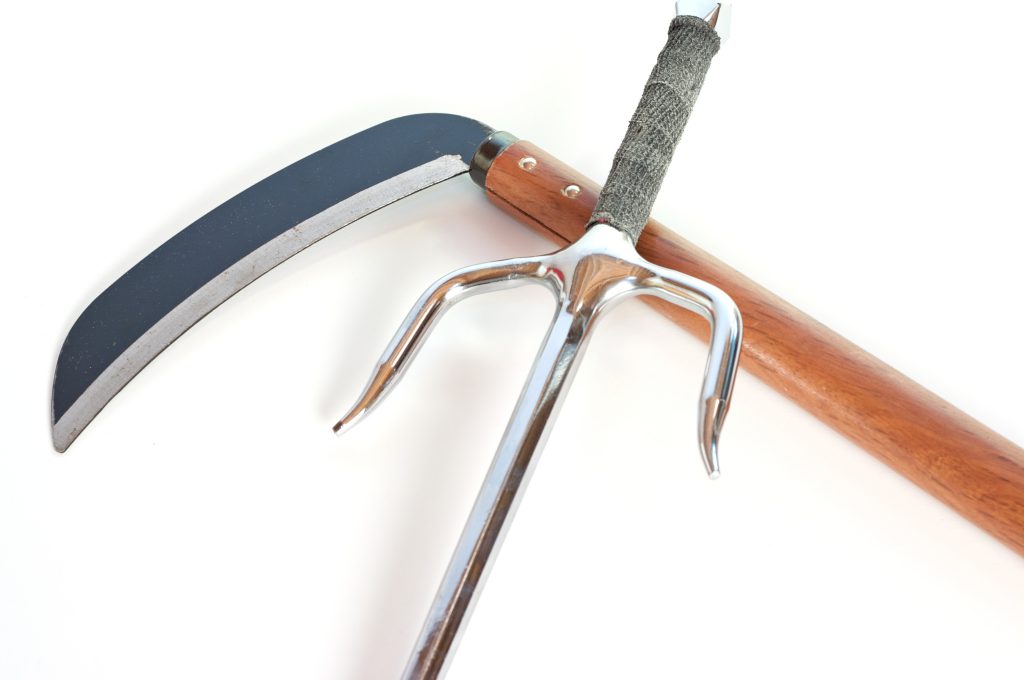Weapons have been a part of martial arts for as long as humans have been fighting with each other. Weapons training can give you a serious edge in self-defense situations and the confidence to stand up for yourself.
But weapons in martial arts aren’t always about self-defense. Sometimes they are used as training aids to improve students’ strength and coordination for empty-hand fighting skills. Others are used artistically to highlight their cultural significance and craftsmanship.
Whatever they are used for, here I wanted to celebrate the best martial arts weapons ever made. I’ve come up with 25, covering all the uses listed above. Let’s check them out!
Table of Contents
25 Best Martial Arts Weapons
I considered ranking this list from worst to best but decided it was near impossible. The ‘best’ martial arts weapon is purely subjective as it depends on your point of view and there are many different types of martial arts weapons.
Some love these weapons for their design or cultural significance, while others appreciate their deadliness or real-world effectiveness. With that in mind, here is my martial arts weapons list!
1. Katana
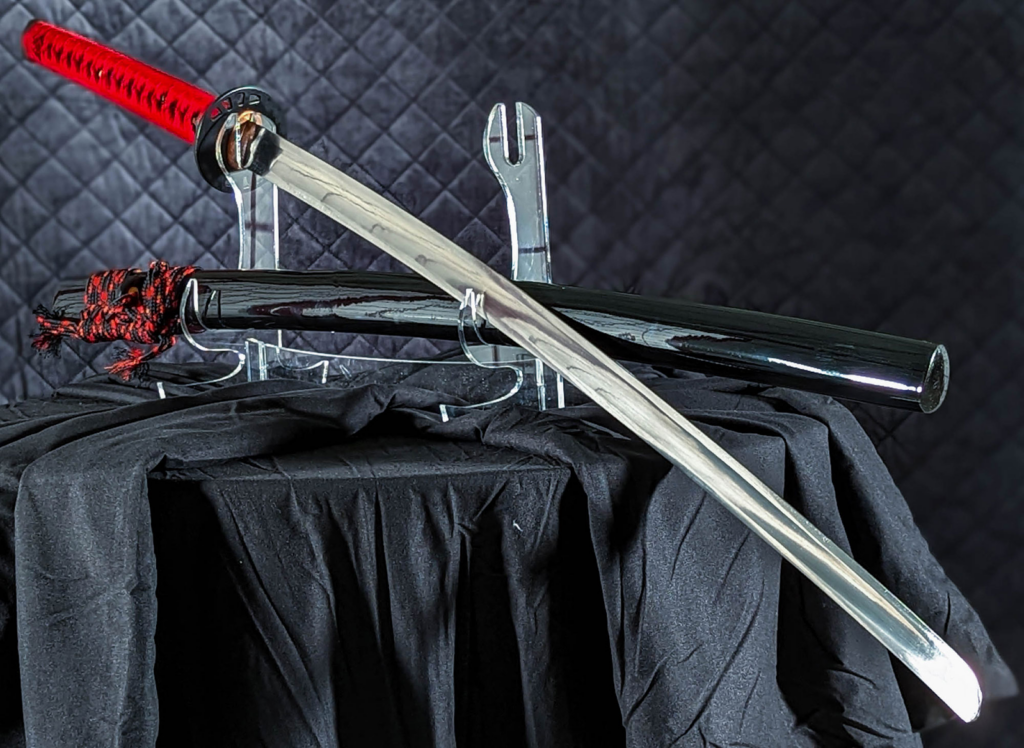
The katana is a classical samurai sword with a single-edged, lightly curved blade around 2-3 feet in length. Traditional katanas were forged using specialized techniques to give them a hard steel edge but a softer steel backing.
This allowed them a razor-sharp cutting edge and the flexibility to not shatter with use. Some historians consider them the best martial arts weapons because of these forging techniques.
Swords and swordsmithing were banned in Japan in the years following World War II, which almost made the katana lost to time, as smithing techniques were directly passed down from master to apprentice. Today, sword smithing for fighting weapons is once again practiced in Japan, but it is a closely guarded piece of cultural heritage.
The katana is still used in several modern Japanese martial arts. Iaido teaches quick-draw techniques using the katana. In Itto-Ryu, students learn traditional dueling techniques for the katana. There is even a modern combat sport inspired by the katana called Kendo, which uses bamboo swords for safe sparring.
Whether you’re looking for a high-energy sparring martial art or a traditional art to develop both body and mind, the katana is a great martial art tool and one of the best Japanese martial arts weapons ever made.
2. Bō Staff

Another of the Asian martial arts weapons, the bō is a wooden staff incorporated into many martial arts, including Okinawan Kobudō, Kung Fu, and Silat.
A bō usually measures around 6 feet long and is made of wood. This weapon originated as a walking stick and tool to balance buckets and was adapted for self-defense.
There are many different techniques for using a bō, ranging from elaborate and beautiful demonstrations to quick and brutal techniques still useful for modern self-defense. The bō can be used to block and deflect incoming attacks, as well as deliver powerful strikes.
Bo techniques in martial arts often teach students to switch between blocks and strikes seamlessly, using momentum to build power.
3. Naginata
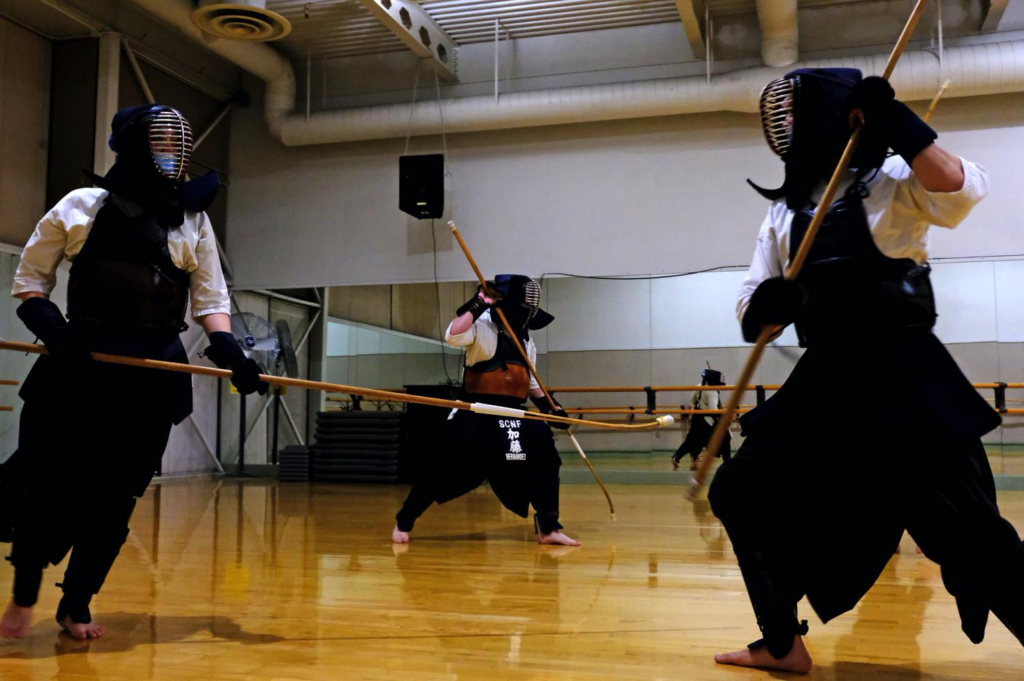
The naginata is a polearm from Japan that was the preferred weapon of the Onna-musha, a class of women warriors who fought alongside samurai in feudal Japan. This weapon became a status symbol and means of home defense for women from samurai clans. Tomoe Gozen, whose story is told in the Japanese historical epic The Tale of the Heike, is an iconic wielder of the naginata.
In feudal times, the naginata was an effective weapon against cavalry. Today, the use of the naginata is taught in the martial art Naginatajutsu, which is divided into two distinct styles, Atarashii Naginata and Koryū Naginata.
Koryū Naginata focuses on historical techniques, while Atarashii Naginata incorporates modern updates, including sport-form sparring competitions. Both styles teach students budō philosophy as a form of self-development.
4. Cane

Canes are taught as a self-defense weapon in the French martial art Canne de Combat. Canes were a popular accessory item for the French upper class in the 19th century, and with training, they could become an effective form of self-defense when traveling through unsafe areas.
The cane was typically around 3 feet long, had handles for better grips, and was usually made of sturdy, tapered hardwood. Weighted tips were sometimes included to increase the power of strikes. Today, Canne de Combat has been adapted into a sport form of martial art and shares some similarities to Olympic fencing.
In the sport form of this martial art, points are scored by making horizontal or vertical strikes, but thrusts are prohibited. While canes aren’t a common fashion item today, the techniques taught by Canne de Combat can still serve as a helpful addition to a self-defense system.
5. Sai

Sai are small, trident-like weapons wielded in pairs. They consist of a long middle prong and two shorter side prongs that double as guards for the handle, typically blunt-tipped and with no cutting edge. Similar weapons are found across Asia, but the modern sai is based on an Okinawan design used by police for crowd control and apprehending criminals.
While some techniques could be deadly, the sai was often used to defeat opponents without killing them. Striking and thrusting techniques were used with the long middle prong of the sai, and the smaller side prongs could be used to catch the blade of a sword and twist it out of the attacker’s hands. Use of the sai is still taught in Okinawan Kobudō and some forms of Karate.
6. Tonfa

Tonfa is a weapon used in Okinawan Kobudō derived from handles used to turn grindstones. Tonfa are made of wood and are typically used in pairs. Like many of the unique weapons used in Okinawan Kobudō, the tonfa’s use in martial arts originated in Okinawan peasants learning to defend themselves with everyday objects since they weren’t allowed to own weapons.
When used in martial arts, the tonfa is held so that the long part of the handle lines up with the user’s forearm. Historically, this would add strength to strikes and blocks. Certain techniques teach students to use the tonfa to hook weapons to disarm opponents.
The dense wood of the tonfa could deliver devastating damage to attackers. In modern Kobudō, tonfa enhances striking techniques and blocks during kata and demonstrations.
7. Nunchaku

Nunchaku is an iconic East-Asian martial arts weapon often seen in movies, cartoons, and video games. The nunchaku consists of two short sticks connected by a short length of chain. Karate, Okinawan Kobudō, Hapkido, and Kung Fu teach students how to use nunchaku.
The exact origins of this weapon are unclear, but some traditions suggest it was originally derived from rice flails used in farming. Some countries restrict citizens from owning nunchaku, with narrow exceptions for martial arts schools.
Several states in the United States banned it as well, stemming from fears sparked by their use in martial arts movies, but all states except Massachusetts have lifted these bans. In addition to martial arts, nunchaku is used in a stand-alone performance art called freestyle nunchaku.
Nunchaku is often used as a training tool to teach quick hand movements. The sticks are typically swung in circular motions to build speed and power for strikes. The chain connecting the sticks can deflect incoming weapons or catch an opponent’s arm.
8. Karambit

The karambit is a specialized knife used in the Southeast Asian martial art Silat. The karambit is a small curved blade, which legends say was inspired by the shape of tiger claws. The end of the hilt has a finger ring to increase maneuverability and make it harder to be disarmed.
This blade was originally designed as a utility knife for farmers, and it continues to be a popular ergonomic knife for everyday use. As the design gained popularity, its potential for a self-defense weapon was recognized.
It became especially popular with women, who would incorporate the knife into their hair pieces to have hidden in case they needed to defend themselves. Unlike the thrusts typically used with straight knives, the hooked karambit blade is designed to hook and tear.
The blade is traditionally held underhand (with the hook pointed up), but some modern styles of Silat also teach students how to use the karambit with an overhand grip (with the tip pointed down) as well. This design makes it an excellent self-defense weapon for fights in close quarters.
9. Kama

Kamas are small Japanese sickles, typically wielded in pairs. They have a few changes from sickles still used in gardening applications to this day and consist of a curved blade on a short handle. Despite their Japanese name, they are used in many East-Asian martial arts, including Karate, Okinawan Kobudō, Taekwondo, and some forms of Kung Fu.
Kamas used for self-defense in the past were used to block strikes from incoming weapons and to disarm opponents. The sharpened blade could be used for deadly counterattacks if necessary.
Today, kamas are typically used as a training aid and incorporated in many elaborate forms and kata, including spinning or twirling the kamas. Training with kamas is a great way to increase hand-eye coordination.
10. Yumi

The yumi is a long asymmetrical bow used in the Japanese martial art Kyūdō. The bow measures over 6 feet long, with the grip located beneath the center of the bow. Kyūdō was formalized into a martial art in 1896 when practical archery skills were combined with ceremonial archery to revive and restore the fading martial art of Kyūjutsu.
This art form which had been practiced by archers in Japan for centuries before the introduction of firearms. Kyūdō is a popular club activity for high school and college students in Japan, and the martial art has spread worldwide.
Kyūdō is about more than just hitting the target accurately. Kyūdō practitioners train for all their movements to be deliberate, smooth, and graceful and are meant to reflect the archer’s spirit and attitude.
Kyūdō is closely connected to both budō (a traditional philosophy of self-development shared by many Japanese martial arts) and Buddism. The philosophy of Kyūdō was popularized outside of Japan with the 1948 book Zen in the Art of Archery by Eugen Herrigel.
11. Shuriken

Shuriken, also known as throwing or ninja stars, is an iconic martial arts weapon associated with the martial art of Ninjutsu. The shuriken is a blade designed to be thrown at opponents. The number of points on a shuriken varies by design, but 4 or 5 points are common.
The shuriken was originally used by samurai in feudal Japan until the Tokugawa period when their use was outlawed. After that, the practice continued underground, where it became associated with Ninjutsu.
Traditionally, the shuriken was used to distract an opponent to either open them up for another attack or gain an opportunity to escape. The blades on a shuriken typically don’t stick out far enough to strike deep enough to cause a fatal wound, so instead, they were most often aimed at the enemy’s face to gain precious seconds that could decide the course of the battle.
Today, shuriken is used for target practice. The correct way to use shuriken is taught both in surviving schools of Ninjutsu and as a stand-alone martial art called Shurikenjutsu.
12. Hook Swords
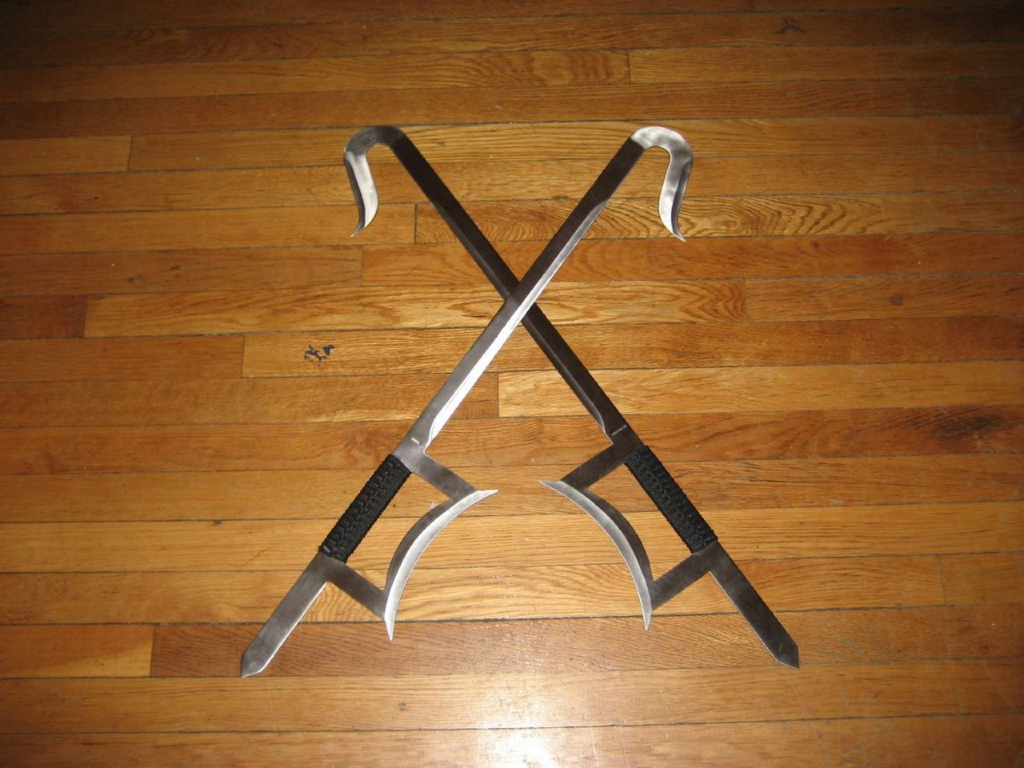
Hook swords are a weapon taught in several Chinese martial arts, including Shaolin Kung Fu. Hook swords are similar in size and shape to a traditional jian sword but with a specialized hooked tip at the end of the blade and a crescent-shaped guard over the hilt. They are typically used in pairs and, in modern times, are used only in forms or demonstrations and not for sparring.
In historical context, the hook at the blade’s tip was used to catch the opponent’s blades. The edge of the blade was sharpened, allowing for slashing cuts. The crescent guard had a sharpened exterior and could be used to slash at nearby opponents and protect the practitioner.
Many historical hook swords had a spiked pommel that could be used for stabbing. Because of the multi-faceted nature of this weapon, demonstrations using it can be particularly elaborate and beautiful, making it a fascinating weapon to learn.
13. Rope Dart
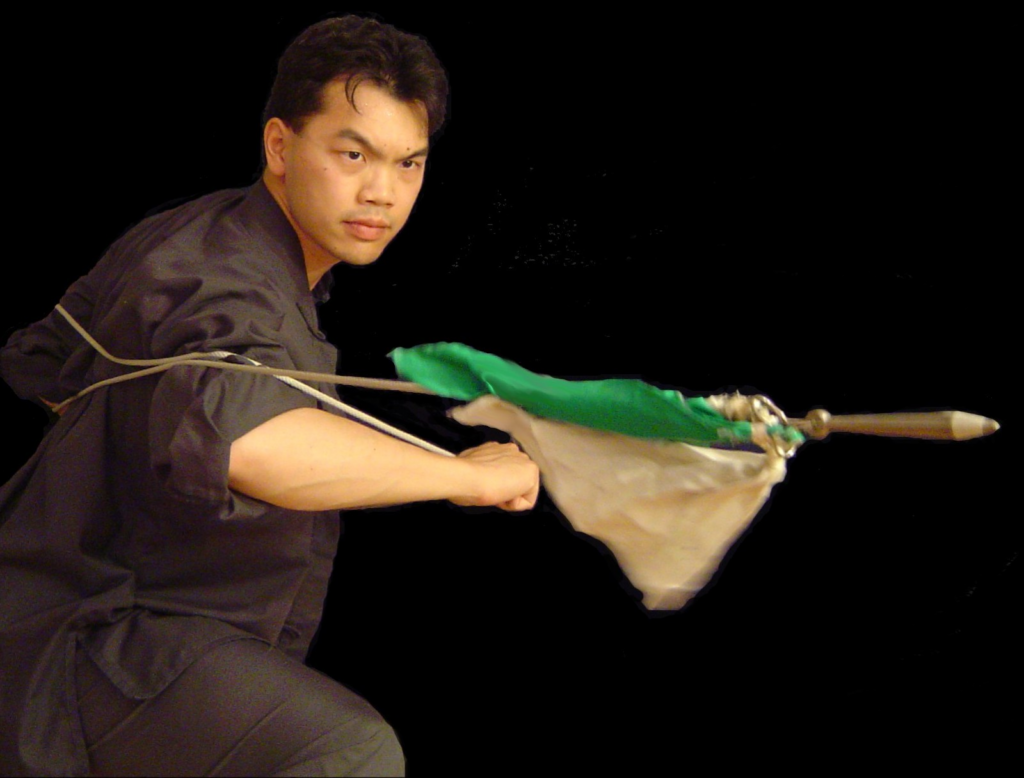
The rope dart, also called the rope javelin, is a traditional Chinese flexible weapon taught in some forms of Kung Fu. The rope dart consists of a pointed metal dart attached to a rope with rings, usually backed with feathers or colorful flags.
The rope dart was a highly niche weapon, with only a few mentions of its use in historical documents. The rope dart served as a reusable throwing weapon since it could be drawn back using the rope.
The modern rope dart is used in demonstrations and as performance art rather than a weapon to fight with. Learning the rope dark teaches students excellent hand-eye coordination. Rope dart routines in Kung Fu are renowned for the grace and skill it takes to perform them.
14. Longsword

The longsword was a two-handed sword popular in many European countries between 1100 and 1700 AD. Designs varied slightly from region to region, but the basic form included a blade sharpened on both edges, a cross guard, and a hilt long enough for two-handed use. The longsword was designed to be used against armored opponents.
The longsword is a favorite weapon of Historical European Martial Arts practitioners. The two most popular forms of HEMA longsword are the German school of Johannes Liechtenauer and the Italian school of Fiore dei Liberi.
Techniques are learned by studying historical manuscripts, practicing solo forms, and, in some schools, sparring with blunt weapons. Longswords are a great weapon to learn for fans of history who want a hands-on approach to the past.
15. Qiang

One of the most traditional martial arts weapons, the qiang is a classical Chinese spear. There are several different head designs for the qiang, each with its unique look. Despite the similar design, the qiang is not designed to be thrown like a javelin.
This weapon was used in battle for thousands of years and was popular with infantry because of its relative ease to master. Some legendary Chinese heroes used the qiang, including Hua Mulan, the inspiration for the Disney movie Mulan.
The qiang is a popular weapon taught in both kung fu and Tai Chi. Both martial arts incorporate slashes, thrusts, wide sweeps, and circular motions. Kung Fu uses it in a quick and acrobatic style, while Tai Chi uses it for balance in slower-moving meditative techniques.
16. Tomahawk
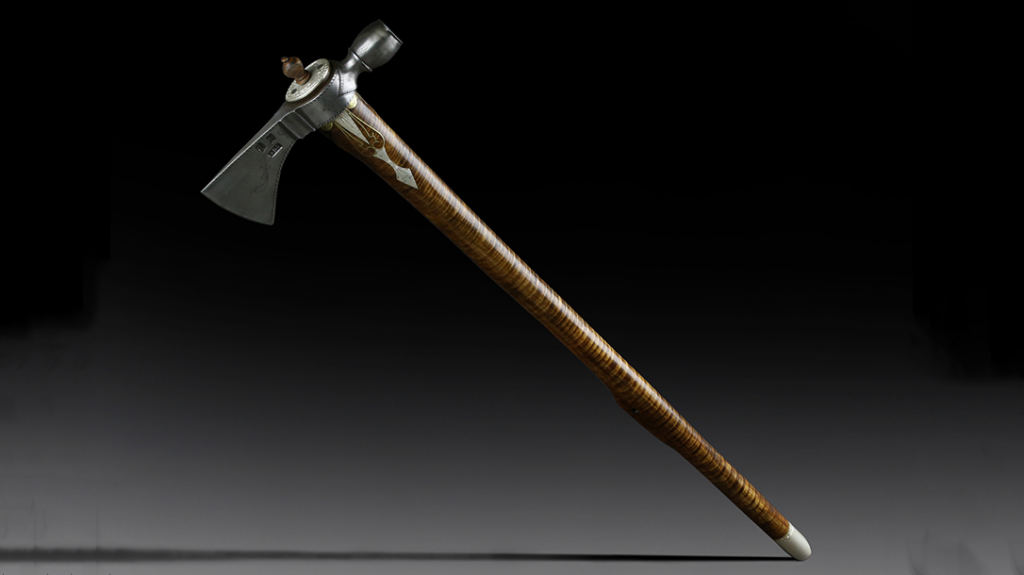
The tomahawk is a light single-handed ax common in pre-colonial North America. The tomahawk was used as an everyday tool and a weapon of war. It could be used up close in melee combat or thrown as a ranged weapon. Similar designs are used today in bushcraft and military applications.
Today, tomahawks are used in tomahawk-throwing competitions, where students learn to throw axes accurately and powerfully. Tomahawk fighting techniques are also taught in Okichitaw, a modern martial art based on the fighting techniques of the Plains Cree tribe. To this day, the tomahawk is a useful tool and a connection to past cultures.
17. Sarong

The sarong is a traditional type of clothing consisting of a long cloth worn around the waist and lower body, and it is still worn to this day in Indonesia, Yemen, Burma, and other nearby countries.
Different colors and designs carry significant meaning and can be used to identify the wearer’s tribe or social status and for specific uses during ceremonies. Along with being a culturally important form of clothing, the sarong can double as a weapon for self-defense.
The martial art Pencak Silat teaches students how to fight using a sarong. Pencak Silat teaches students how to use the sarong to deflect blades or to entangle and snare attackers. Some techniques involve wrapping up a rock in the sarong cloth to use as a deadly mace to swing at attackers.
Some of these techniques can be modified to work using other kinds of clothing, making it a good weapon to learn to defend yourself when no other weapons are available.
18. Knife

Knives are a weapon taught by many modern self-defense focused martial arts, such as Krav Maga, Eskrima, Sambo, and even modern military training. Self-defense focused martial arts teach students how to use knives in self-defense and defend against attackers armed with knives.
Since knives are deadly even when used by untrained attackers, good martial arts training can be the difference between life and death in a knife fight.
Because knives in martial arts are primarily used for self-defense, many techniques are fast, aggressive, and deadly. Sticks, rubber knives, and blunted blades are often used as stand-ins for real sharp knives for safe practice in martial arts training.
Whether a utility knife for everyday use or a tactical knife made for fighting, learning martial arts knife techniques can be critical to an effective self-defense system.
19. Meteor Hammer
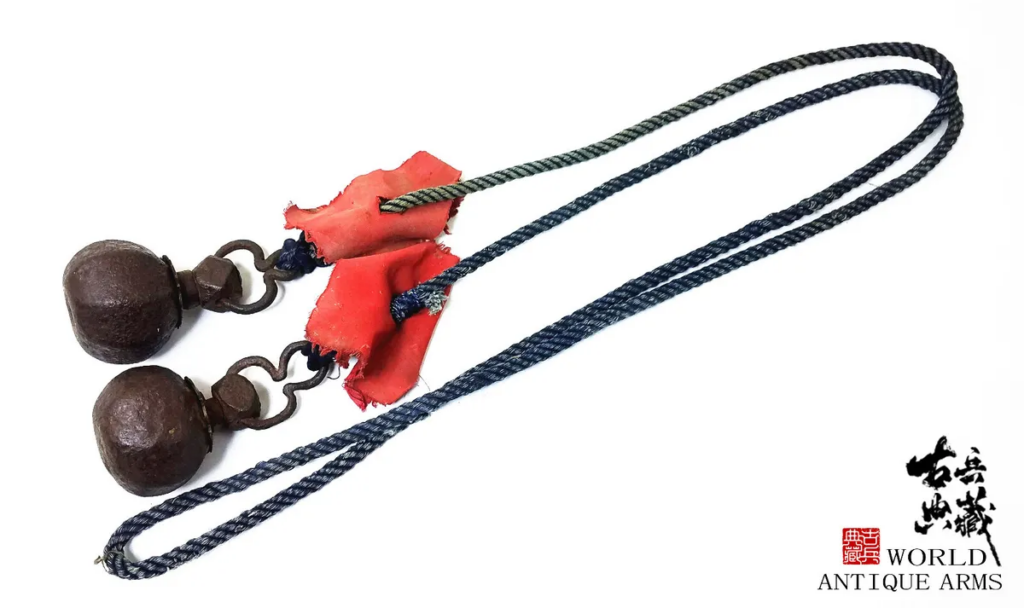
The meteor hammer is a flexible weapon from China taught in some forms of Kung Fu. The basic design consists of two weights (some designs use only a single weight) connected by a length of chain or rope.
The weights are swung on the rope, making them a flail-type of weapon. The meteor hammer has always been a specialized niche weapon, and only a few historical instances show their use, such as in illustrations in historical documents.
Today, the meteor hammer is primarily used in demonstrations rather than as a weapon for self-defense. Training to use the meteor hammer takes a lot of skill and training, and routines that incorporate them are breathtaking. When used by a skilled martial artist, the weights are swung together in complicated patterns without becoming entangled.
20. Handgun

While many martial arts focus on historical weapons, others incorporate the use of firearms, especially handguns, into their techniques. Hōjutsu is a martial art originating in Japan that teaches students how to use historical black-powder firearms while incorporating the budō philosophy common in many Japanese martial arts.
Combat Pistol Shooting is another martial art discipline that teaches the use of handguns for both self-defense and military use. It was developed by British police officers stationed in Shanghai in the early 20th century and spread worldwide during World War II.
Cowboy Action Shooting is another combat sport that teaches practitioners shooting skills and techniques from the American Old West, using primarily historical firearms that have changed little over the centuries.
No matter which martial art you choose to learn handgun techniques, all guns are serious weapons that must be treated carefully and with respect. Handguns, in particular, are often subject to strict laws since their small size makes them easier to conceal than long guns.
Before you start to learn a martial art that teaches handgun techniques, always consult your state or country’s laws on the lawful use of handguns.
21. Machete
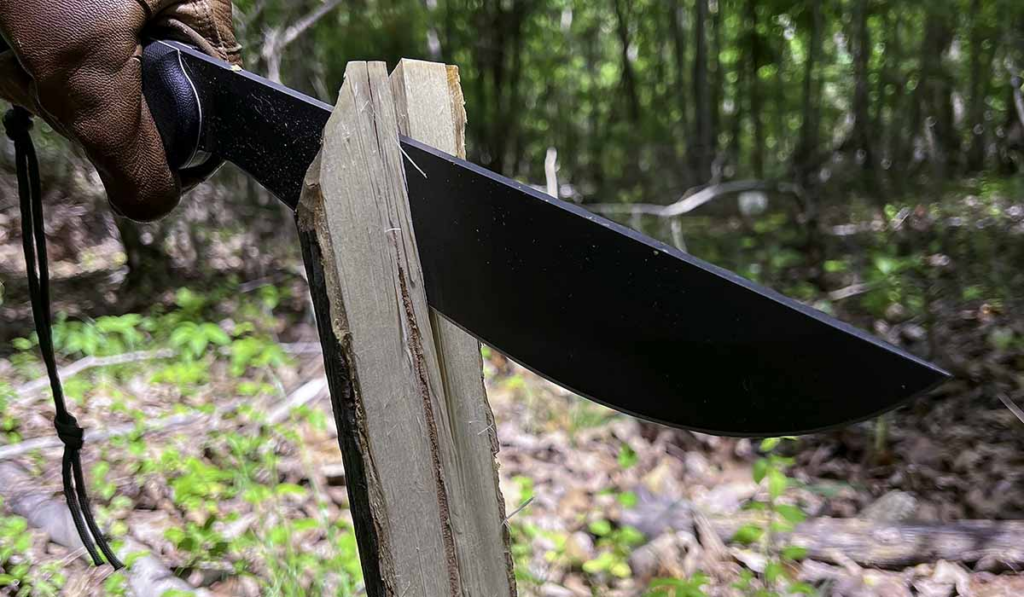
The machete is a blade often used in agriculture in countries with thick vegetation, such as the tropics or rainforests. It has a thick, heavy blade, often with one smooth side and an optional serrated back, and has no guard between the blade and the hilt.
It’s used to clear nuisance plants and harvest crops such as sugar cane. The machete has also been used as a weapon for self-defense and as a tool for war in many conflicts, especially in South America and Africa.
The machete was one of the primary weapons used during the 1791 slave revolt in Haiti, where the people being kept as slaves overthrew the French colonial government that ruled Haiti at the time.
Many different South American countries have their own forms of martial arts that use the machete. Arma Blanca and Machete Cubano were both forms of machete fighting used by Cubans during their war for independence against Spain toward the end of the 19th century.
Columbian Grima is a type of machete fighting influenced by European fencing styles and is still taught today. Juego de Machete is a Haitian martial art that passes down machete techniques used in the Haitian Revolution. Across the world, the martial art Eskrima also teaches practitioners how to fight using the bolo, which is a Philippine version of the machete.
22. Klewang
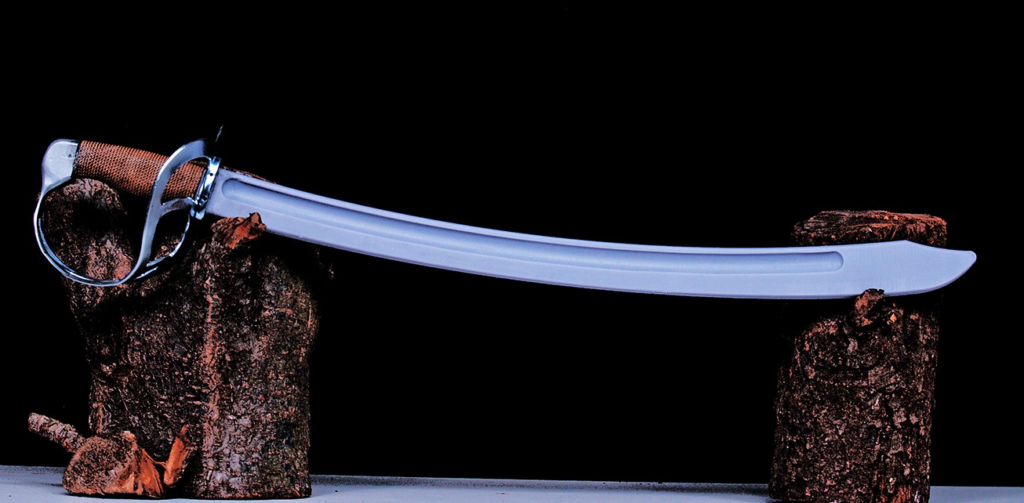
The klewang is a unique sword originating in Malaysia and Indonesia that features a single edge and a protruding notch near the tip of the blade. Designs vary regionally, but klewang are often tapered in reverse, with a narrow base and wider tip.
Many designs also incorporate a bent hilt. This blade is still used for ceremonies and for combat today and isn’t an uncommon weapon to be used regionally in gang violence.
Pencak Silat teaches fighting techniques using the klewang. It is used regionally as a sword with a fighting style similar to the naval cutlass but with its unique flair. It can also be used as a tool similar to the machete to clear away dense vegetation. The unique notch at the blade’s end is considered primarily decorative.
23. Eku
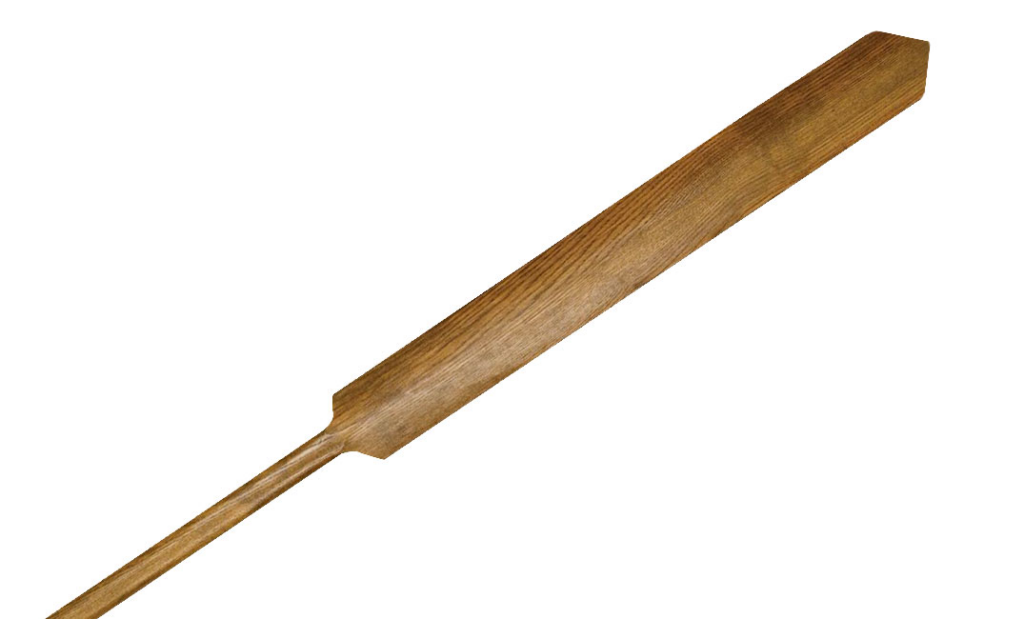
The Eku is a weapon unique to Okinawan Kobudō based on boat oars. The eku features a wooden paddle mounted to a long pole, usually 5-6 feet long. Like many weapons in Okinawan Kobudō, the eku was adapted for self-defense.
This happened when peasants on the Okinawan island were forbidden from owning swords and other conventional weapons of the time. Instead, they needed to learn to defend themselves with tools they were allowed to handle, such as boat oars and farming implements.
Fighting techniques using the eku resemble bō fighting techniques but are modified to account for the different center of gravity that the paddle at the end of the handle causes.
The handle was used for blocks, and strikes using the thin edge of the paddle could cause significant damage to the attacker. One unique technique to the eku was to use the paddle to quickly scoop up sand and fling it into an attacker’s eyes, which takes a lot of practice to master accurately.
24. Gakgung

The gakgung, which translates to “horn bow”, is a short Korean reflex bow based on the shape of water buffalo horns. Modern gakgung are typically made of wood and still feature the unique curved design inspired by buffalo horns. These short bows were used both on foot and on horseback, with records of their use dating back over 2,000 years.
Today, the gakgung is taught in the Korean martial art Gungdo. Some Taekwondo schools also incorporate the gakgung, but this is rare outside of Korea. Gungdo as a martial art hasn’t spread far out of Korea, but it has a deep association with the national image of Korea.
Archery is a common sport in Korea with deep ties to the country’s cultural heritage, and Korean athletes often perform very well in Olympic archery events.
25. Tekkō
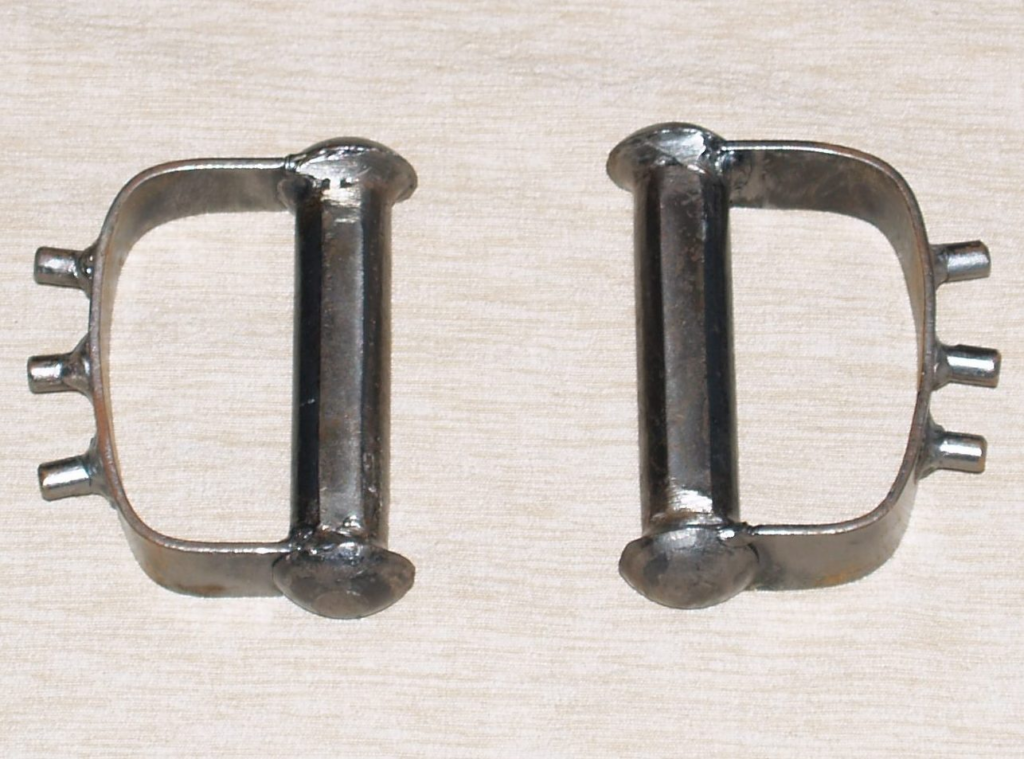
The tekkō is a weapon taught in Okinawan Kobudō, similar to modern brass knuckles. Tekkō were originally derived from horse stirrups, with the bottom used as a handle and the metal arch used to protect the knuckles when striking and increase the weight and strength of punches.
Several different designs for tekkō are used in modern Kobudō, with the most common resembling a small square stirrup with claw-like protrusions on the outside. Training tekko are often made of metal, but wood or plastic versions are used in some dojos, especially where brass knuckles are restricted.
The techniques resemble open-hand techniques, with some special twists to take advantage of the design and heft of the tekkō. While the tekkō is primarily used only for training and demonstrative purposes today, the techniques learned by training with the tekkō can add a unique dimension to your personal self-defense system.
FAQs – Best Martial Arts Weapons
Which weapon is best for fighting?
Perhaps it’s a boring answer, but it’s probably the modern tactical knife. This is light, versatile, and can be used effectively by anyone. This is, of course, a deadly option and should only be used when your life is in imminent danger. For non-lethal weapons, a blunt stick/baton is your best bet in terms of traditional weapons, but in modern times, a taser would be the most effective solution.
What is the most difficult weapon to master?
Nunchaku (nunchucks) probably has the steepest learning curve, as it’s easy to hurt yourself when starting out. There are other difficult weapons, too, such as a traditional bow, that take a huge amount of strength and require precision. A sword such as a katana may seem easy enough to use, but it takes many years to master.
What weapon does Bruce Lee use?
Bruce Lee used many types of weapons in his martial arts training and film roles. In his martial arts training, he’d used the likes of the rattan. In his film roles, some famous weapons he used include the bo staff, kali sticks, and nunchaku.
Are there any gun martial arts?
Yes, there are quite a few martial arts that use guns. Some are included in my ‘handgun’ section above that have gun training in their curriculum. Military martial arts such as Krav Maga, MCMAP, and Systema also teach you how to use weapons and disarm an opponent.
What is the best weapon for a street fight?
This is a very difficult question to answer as we don’t want to promote violence, don’t want you to be in dangerous situations, and it depends on the circumstances. In reality, if you feel as though your life is threatened, then the best thing to do is run or call for help.
While a gun or a knife are the deadliest weapons, the best thing to defend yourself with is usually a weapon that is light, blunt, and easy to swing. In this respect, a baton is a great option, as it will often put off a potential attacker.


